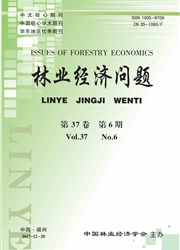

 中文摘要:
中文摘要:
基于吴起农户调查面板数据,采用统计描述法和结构方程分别对退耕农户复耕的可能性进行甄别,并分析了农户退耕还林持续性传导路径。结果表明:不同复耕意愿农户非农化程度存在显著差异;农户非农化程度与退耕还林可持性之间显著相关,即农户非农化程度越高,农户复耕可能性越低;且以补助作为激励手段作用依然存在,但影响不如非农化程度对退耕还林可持续性影响大。因此,为保证退耕还林工程可持续性,一方面应为农户创造更多非农就业机会,消除农户难以向非农产业转移的障碍;另一方面应实行有差别的补助标准,提高大规模退耕且主要从事农地经营农户的退耕还林补助标准。
 英文摘要:
英文摘要:
Basing on the household panel data of Wuqi county, using descriptive statistics and structural equation model, this article estimates the possibility of household returning forest to farmland and their keeping slope land conversion program sustainable path. The results show that there is a significant difference in non-agricultural property of farmer between different willingness of returning forest to farmland. The results of structural equation model indicate that there is a significant relationship between non-agricultural degree and the sustainability of returning farmland to forest. That is, the higher the non-agricultural degree of farmers, the lower the possibility of rehabilitation. In addition, subsidies still have a significant influence on the sustainability of returning farmland to forest, but its impact is smaller than the degree of non-farm. Therefore, in order to ensure the sustainability of the SLCP, more non-farm employment opportunities for farmers should be provided. Meanwhile, increasing the subsidies of farmers who are mainly engaged in farmland and return large-scale farmland to forest, is a way to solve these problems.
 同期刊论文项目
同期刊论文项目
 同项目期刊论文
同项目期刊论文
 期刊信息
期刊信息
